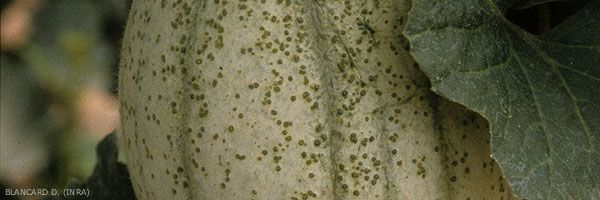
Intumescences
When the humidity under the plant canopy is very high, can appear on the upper surface of the leaves spots which tend to necrosis (figure 1). On the underside, it can be noted that these spots correspond to islets of cells which have burst as a result of excessively high humidity (FIG. 2). This damage is especially observed in crops under plastic tunnels, under caterpillars and agro-textiles, which tend to maintain high humidity around the plants.
Melon fruits frequently exhibit very characteristic small superficial changes that producers wrongly attribute to pest damage (thrips bites, etc.). This is not the case, these symptoms are in no way caused by an insect. The high humidity prevailing under the various shelters (tunnels, caterpillars ...) and in particular under the plant cover is at the origin of the latter. Islands of water-saturated epidermal cells swell slightly and take on an oily tint (Figure 3), and the distended cuticle eventually bursts (Figure 4). Their subsequent healing gives them the appearance of small corky pustules (figure 5).
The damage is always very superficial and only depreciates the appearance of the melons.
The damage is always very superficial and only depreciates the appearance of the melons.
This non-parasitic condition manifests itself particularly in spring or whenever there is high humidity linked to the climate prevailing in the open field or under shelters and / or heavy irrigation, in particular by sprinkling.
To remedy intumescence, whether on leaves or fruit, it is advisable to reduce the ambient humidity when possible, by ventilating the shelters as much as possible, for example, by managing the irrigation as well as possible, in particular the sprinkling.





